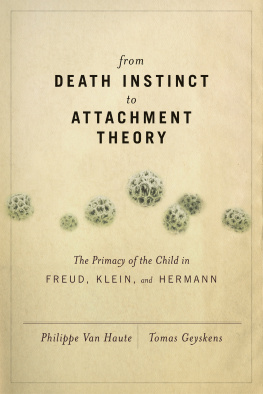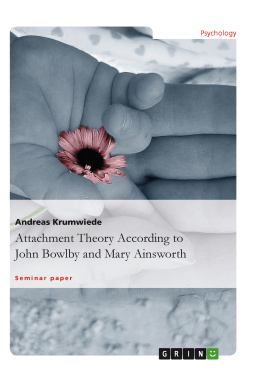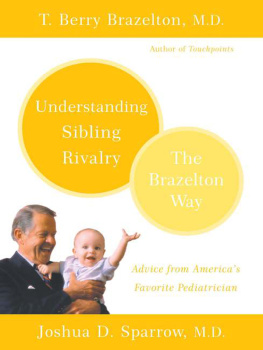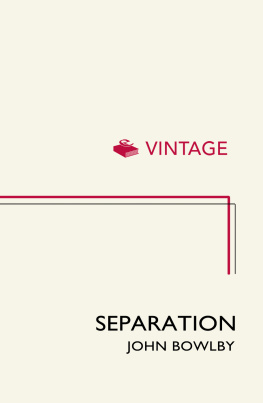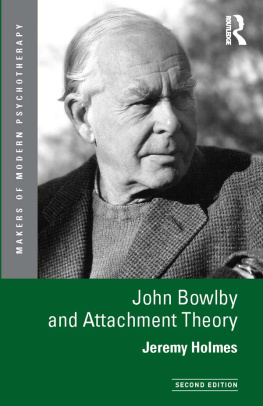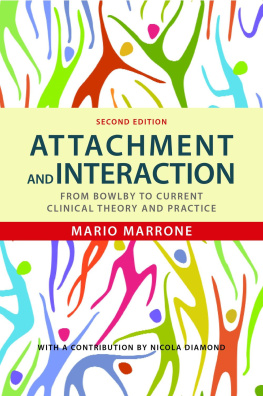Carol Garhart Mooney - Theories of Attachment: An Introduction to Bowlby, Ainsworth, Gerber, Brazelton, Kennell, and Klaus
Here you can read online Carol Garhart Mooney - Theories of Attachment: An Introduction to Bowlby, Ainsworth, Gerber, Brazelton, Kennell, and Klaus full text of the book (entire story) in english for free. Download pdf and epub, get meaning, cover and reviews about this ebook. year: 2009, publisher: Redleaf Press, genre: Home and family. Description of the work, (preface) as well as reviews are available. Best literature library LitArk.com created for fans of good reading and offers a wide selection of genres:
Romance novel
Science fiction
Adventure
Detective
Science
History
Home and family
Prose
Art
Politics
Computer
Non-fiction
Religion
Business
Children
Humor
Choose a favorite category and find really read worthwhile books. Enjoy immersion in the world of imagination, feel the emotions of the characters or learn something new for yourself, make an fascinating discovery.

- Book:Theories of Attachment: An Introduction to Bowlby, Ainsworth, Gerber, Brazelton, Kennell, and Klaus
- Author:
- Publisher:Redleaf Press
- Genre:
- Year:2009
- Rating:3 / 5
- Favourites:Add to favourites
- Your mark:
- 60
- 1
- 2
- 3
- 4
- 5
Theories of Attachment: An Introduction to Bowlby, Ainsworth, Gerber, Brazelton, Kennell, and Klaus: summary, description and annotation
We offer to read an annotation, description, summary or preface (depends on what the author of the book "Theories of Attachment: An Introduction to Bowlby, Ainsworth, Gerber, Brazelton, Kennell, and Klaus" wrote himself). If you haven't found the necessary information about the book — write in the comments, we will try to find it.
Theories of Attachment: An Introduction to Bowlby, Ainsworth, Gerber, Brazelton, Kennell, and Klaus — read online for free the complete book (whole text) full work
Below is the text of the book, divided by pages. System saving the place of the last page read, allows you to conveniently read the book "Theories of Attachment: An Introduction to Bowlby, Ainsworth, Gerber, Brazelton, Kennell, and Klaus" online for free, without having to search again every time where you left off. Put a bookmark, and you can go to the page where you finished reading at any time.
Font size:
Interval:
Bookmark:
THERE ARE ALWAYS SO MANY PEOPLE to thank when a book moves from an idea to a reality. The first person I think of in helping me successfully make this transition is my editor, Beth Wallace. Her skill, good humor, professionalism, and patience get me through every time. I thank David Heath and Linda Hein at Redleaf Press for ensuring that editorial relationship, which works so well.
Next I thank my son, Brian Mooney, MHAwould-be agent and arranger of international phone calls, hospital tours, and all issues his mom usually struggles with. His knowledge of hospital practice, past and present, has been invaluable to the completion of this text. I also thank his colleagues at Exeter Hospital for showing me how far we have come since I gave birth there decades ago.
I thank my friends Patrice, Joanne, Ann, and Pat for their continual support of my work and their responses to urgent calls whenever Im not sure what to do next. Their calls, e-mails, flowers, and encouragement keep me going. Their friendships sustain all that I do.
Special thanks are due to Johann Mooney, Lea Janelle Walsh, Stacey Jordan, and Katie Brissette for their honesty and reflection on the role of motherhood in the modern world.
I thank Stacey Jordan, Joanne Parise, Meghan Adams, and LeeAnn McIntyre for modeling expert relations with parentsbefore becoming parents themselves.
I thank my workplace, The Sisters of Holy Cross, specifically Carol Descoteaux, CSC, General Animator, USA, for valuing the contribution of practical texts to the field of early childhood education and for encouraging my continued attempts to contribute to the field.
The completion of this text has depended on the support of friendships in the early childhood and broader communities of New Hampshire, which have sustained my effort for nearly forty years. The names are too many to list and my fear is I would forget someone, so Ill state only that you know who you are. The New Hampshire tornado of 2008 stole time, records, and energy from this effort that were restored, however, through the tireless efforts and support of my longtime friends Susan Rowe Morison and MaryLou Beaver. Your organization of Early Learning New Hampshire disaster relief efforts was extraordinary. For the same reason, I also thank Governor John Lynch for his longtime support of early childhood programs and his specific support of my situation after the storm. My longtime friend Chickie Shanelaris is responsible, once again, for getting my book out. Her efforts have supported every text Ive put in print. Each cover bears my name, but it would not have seen print without her!
The final work on this manuscript could not have been completed without the support, skill, and sensible suggestions of Kyra Ostendorf at Redleaf Press. I am truly grateful.
I thank my friend, colleague, and moral compass, Yvette Robert, CSC, for her stories, prayers, jokes, and guidance, without which this work would not have been accomplished.
Finally, I thank my family, who always lead the line of those supporting my life and work. My children, Sean, Brian, Tom, and Erin, and my daughters-in-law, Johann, Gail, and Angie, are my cheerleading squad, interpreters of the modern world, and most serious critics, who say, We love you, Momlet us save you from saying the wrong thing! And finally, love and thanks to my partner, Marc, whose support, administrative skills, and presence keep me going when the going gets rough.
Were done!
Carol Garhart Mooney
Barnstead, New Hampshire
2009
Also by Carol Garhart Mooney
Reflections on Parenting (New England AEYC)
Theories of Childhood
Use Your Words
When a baby is born he cannot tell one person from another and indeed can hardly tell person from thing. Yet, by his first birthday he is likely to have become a connoisseur of people. Not only does he come quickly to distinguish familiars from strangers but amongst his familiars he chooses one or more favorites. They are greeted with delight; they are followed when they depart; and they are sought when absent. Their loss causes anxiety and distress; their recovery, relief and a sense of security. On this foundation, it seems, the rest of his emotional life is builtwithout this foundation there is risk for his future happiness and health.
John Bowlby (1967)
. It has been said that his own childhood experiences drove his professional interest and gave him tremendous sensitivity to the suffering of young children.
Bowlbys father was a surgeon. He directed John to medical school. Bowlby was an excellent student and won prizes for outstanding intellectual achievement. He began his career at Trinity College, Cambridge. He took time after college to volunteer for children with serious emotional and behavioral challenges. From the beginning, Bowlby was interested in the connections between family life and childrens mental health and behavior. Though this connection is commonplace to the study of child growth and development today, it was uncommon at the time.
A friend urged Bowlby to change the direction of his study from medicine to psychology. While still in medical school, he enrolled in the Institute for Psychoanalysis. Though qualified in both medicine and psychoanalysis, Bowlbys sustained interest was in the mental and emotional health of children. From his earliest studies, Bowlby was convinced that deviant or troubled behaviors in late childhood and adolescence had their origins in the family system. He believed the first relationships in infancy set the tone for all later love relationships. He believed that disruption to these first relationships or poor quality in these relationships accounted for trauma and troubling behaviors in adolescence and adult life.
His ideas were not well received in the psychoanalytic community. The prevailing thought at the time was that one needed to look inside the mind at dreams and fantasies to determine the source of neuroses or deviant behaviors. The analysis of troubled individuals was the foundation of psychoanalytic studies. Bowlby believed that observation would yield more information about an individuals reality. He believed the troubled youth he worked with experienced problems because of external causes rooted in their homes and in the earliest experiences that had occurred there or, conversely, in the situations that ideally should have occurred there but did not.
Bowlbys first professional papers presented the idea that two environmental factors early in life can introduce lifetime challenges for individuals. The first of these, which received much negative attention in his early career, is that separation from or the death of a mother results in lifelong struggles for the individual. The second, which today seems like an ordinary idea, is that the emotional attitude of a parent toward a child has life-shaping effects.
Bowlby proposed that often the attitude of a parent toward a child is deeply affected by unresolved issues from his or her own childhood. Today these ideas are accepted as commonplace by psychologists, educators, and sociologists and are part of the well-known foundations of development. When Bowlby first presented his ideas, they were not taken seriously by academicians in any discipline.
At the time, analysts tended to focus on problems around feeding, toileting, or exposure to parents sexual intercourse. All of these issues and their interpretations tended to flow from Freuds theory and practice of psychoanalysis. So when Bowlby suggested that observations of parental behaviors in the home might provide a clue to a childs development, he was largely dismissed by the psychoanalytic community. At the time, analysts did not consider it part of their task to give any consideration at all to the real experiences of patients. Almost by definition it was assumed that anyone interested in the external world could not be interested in the internal world, indeed was almost certainly running away from it (Karen 1998, 38).
Font size:
Interval:
Bookmark:
Similar books «Theories of Attachment: An Introduction to Bowlby, Ainsworth, Gerber, Brazelton, Kennell, and Klaus»
Look at similar books to Theories of Attachment: An Introduction to Bowlby, Ainsworth, Gerber, Brazelton, Kennell, and Klaus. We have selected literature similar in name and meaning in the hope of providing readers with more options to find new, interesting, not yet read works.
Discussion, reviews of the book Theories of Attachment: An Introduction to Bowlby, Ainsworth, Gerber, Brazelton, Kennell, and Klaus and just readers' own opinions. Leave your comments, write what you think about the work, its meaning or the main characters. Specify what exactly you liked and what you didn't like, and why you think so.

